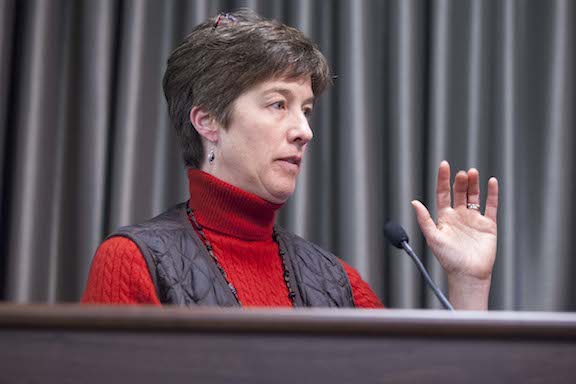Julie Mayfield, co-director of the WNC Alliance, has been a key player in pushing local government to support an I-26 plan. But the nonprofit she directs has helped organize one of its most prominent opposition groups. Photo by Alicia Funderburk
By David Fobes and Jake Frankel
After being off the radar for years, both the Buncombe County Board of Commissioners and Asheville City Council are voting on a resolution to push the Interstate 26 connector forward. This new push is, in part, the result of a small group of local officials and leaders who have met to draft a new resolution and make some sort of I-26 overhaul a reality.
An informal group of seven people — Asheville Vice Mayor Marc Hunt, City Council member Jan Davis, Commissioners Joe Belcher, Brownie Newman and Holly Jones, former Mayor Lou Bissette (representing the Asheville Area Chamber of Commerce) and WNC Alliance Co-Director Julie Mayfield — have met regularly for about 18 months to work out a way to push the connector forward.
All their respective groups were concerned about the long history of delays in the I-26 connector project, which has been marked by an inability of local governments to agree on a route, as well as by local opposition to the number of homes that communities would lose and the potential damage the project could do for years to come.
“After [state Rep.] Nathan Ramsey took office, he chose to push it from his seat,” Hunt tells Xpress. “We sensed it was time for a responsible group of community leaders to get together. It started as comparing notes: Are there ways we could to this thing more efficiently? This self-selected group emerged to keep the dialogue going.” They were also spurred by a new state law that overhauls how the N.C. Department of Transportation determines its funding priorities.
Hunt, Newman, Jones and Davis already have seats on the French Broad River Metropolitan Planning Organization, an influential partnership that makes decisions about transportation planning for Western North Carolina.
“It was basically just community leaders coming together to try to move the project forward,” Belcher tells Xpress.
It hasn’t always been a comfortable process. Hunt admits to “difficult moments” and says the group was on the verge of splitting several times over their differences. He adds that the language of the resolution and its recommendation for Alternative 3C both emerged out of the working group. “It was very much a collaborative effort,” he says. The group also talked extensively to state officials, other local government leaders, local neighborhood and transportation advocates and government staff, he says.
“It’s not something everyone agrees with 100 percent, but it could function,” Hunt says. “This is not a unanimous endorsement, we don’t all see this exactly the same.” Nonetheless, he says it’s a common resolution that addresses the concerns of multiple governing bodies and gives a good framework for the MPO to address.
“It was a result of what we thought was best for the community at large,” Belcher says. “Everybody gave a little bit of input, so that people didn’t feel like they were being left out. That was a big part of what we were doing: making sure we were addressing everyone’s concerns for the process of prioritization.”
While Hunt emphasizes that he’s not formally endorsing the Alternative 3C interstate route, both he and Belcher say that it does have positives, such as a lower cost and leaving the Burton Street and Emma communities comparatively unscathed. Both men note that the process isn’t over.
“There will be quite a bit of additional community input for them N.C. DOT to make adjustments and changes and things,” Belcher says.
However, not everyone agrees with the new push and the emphasis on the Alternative 3C. Some critics say that if the N.C. DOT opts to move forward with that route based on local government recommendations, the community could have little opportunity to change course down the road. ConnectUS, a group with representatives from local neighborhoods (including West Asheville, Montford and Burton Street) affected by the project and the Asheville Design Center both oppose the resolution. A number of opponents spoke at the Tuesday March 18 commissioner meeting (the board passed the resolution unanimously).
Council will vote on the resolution Tuesday, March 25, and the MPO will take it up on Thursday, March 27.
Asked about the opposition, Hunt says he understands their concerns but feels “the theme is more towards an idealized project that would really match with community needs better.”
Hunt acknowledges that even with some improvements, 3C “is not what I would choose if I had my choice in this matter.
“But pragmatically we’re dealing with people with different views, people with different levels of power, with different agendas. My take is insisting on idealized outcomes and holding out only for that doesn’t necessarily yield a productive outcome. This is a very strong effort to find some commonalities, a ‘sweet spot’ of how to move forward.”
He adds that his final endorsement will partly depend on the results of an environmental impact study that will probably take place several years down the road, and he adds he could see another intense debate then.
On an optimistic note, Hunt likes 3C’s reduction in the number of people who will be relocated and believes that the state Department of Transportation is far more receptive than before to making extensive bike and pedestrian infrastructure part of the overall project. The resolution calls for such features and they could have a positive impact on how traffic works in Asheville.
“I think that’s essential in any plan,” he says.




What is this group’s stance on the number of lanes? Will West Asheville be plowed by the 8 lanes NCDOT is hell-bent on building?